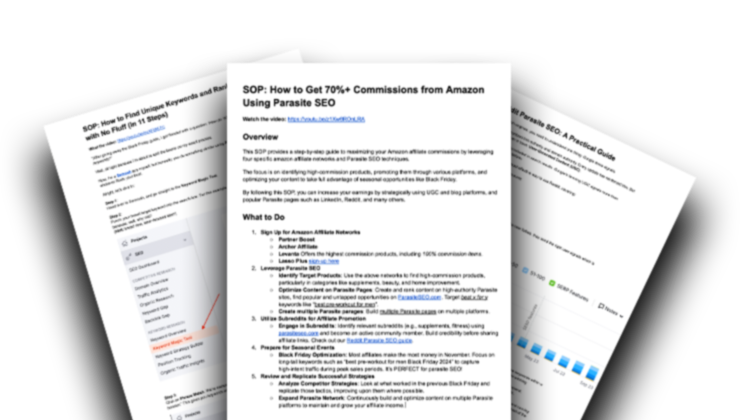SaaS SEO Secrets: A Step-by-Step Framework
Let’s get one thing straight: there are a dozen ways to drive traffic to your site. You can write blog posts, create videos, launch a podcast—even do TikTok dances if that’s your thing. But for SaaS founders, the real goldmine is organic traffic—people already searching for a solution to the exact problem your software solves.
And when it comes to organic traffic, I’m not here to play games.
I prefer the strategy that gets buyers in the door—not just browsers.
Not just top-of-funnel brand fluff, but bottom-of-funnel money-in-your-pocket kind of traffic.
The #1 Rule of SaaS SEO: Don’t Reinvent the Wheel
Here’s the truth:
If something is already working for someone else in your niche…
make it work for you.
How?
By reverse engineering your competitors and ethically stealing their traffic.
That’s not shady—it’s smart.
Because the goal isn’t to reinvent. The goal is to dominate.
“Good artists copy. Great artists steal.”
– Pablo Picasso (and also every great marketer ever)
Now, when I say “steal,” I don’t mean plagiarize. I mean study their content, understand what’s ranking, what kind of tools they’re building, and what their funnels look like. Then build your version—only better.
Step 1: Prioritization (A SaaS Superpower)
Before we dive into the tactics and keyword strategies, let’s address the most important thing nobody talks about…
Prioritization.
You’re a founder, not a full-time content team.
You’ve got limited time. Limited money. Limited energy.
That means not all content is worth creating.
So before you go writing 50 blog posts or building fancy calculators, ask:
“What’s the one piece of content or one tool I could launch that would bring the highest return?”
Put your product manager hat on. Do the research. Run a light-weight competitor audit. And figure out what content can actually move the needle.
Getting five paying customers this month instead of next?
That could be the difference between a failed project and a six-figure ARR business.
Step 2: Reverse Engineering 101
This is where the magic happens.
I’ve spent years studying what the top SaaS companies are doing—multi-million and even billion-dollar brands—and found the common threads in their SEO strategies.
You don’t need to guess. You just need to spy, model, and execute.
Here’s how to get started:
- List out your top competitors
(Look for both direct and indirect competitors ranking for your dream keywords.) - Pull all their SEO keywords
(Use tools like Ahrefs, or SEMrush, to grab the data.) - Merge and de-duplicate the keyword list
(You’ll likely see a ton of overlap. That’s a good sign.) - Filter and prioritize
(Pick keywords based on intent, difficulty, and business value.)
Pro tip: Look for bottom-of-funnel keywords first. “Best [tool category] for [target market]” will always outperform “what is [tool category]” in terms of revenue.
Step 3: Targeting Money Keywords
Now that you’ve got your list of competitor keywords, it’s time to zero in on the ones that actually make you money.
These are called money keywords.
They’re usually lower in search volume—but high in buyer intent.
In other words, they live at the bottom of the funnel (BOFU), where the real action happens.
Here’s what to look for:
| Intent | Example Keyword | Funnel Stage |
| Comparison | Airtable vs Notion | BOFU |
| Alternatives | Monday.com alternatives | BOFU |
| Pricing | ClickUp pricing | BOFU |
| Free Trial | Free CRM software trial | BOFU |
| Review | HubSpot CRM review 2025 | MOFU / BOFU |
| Cancellation | How to cancel Salesforce subscription | BOFU |
| Integration | Trello Slack integration | MOFU / BOFU |
| Industry-Specific | Best HR software for healthcare | MOFU / BOFU |
| Feature/Use Case | Automated invoice software for freelancers | MOFU / BOFU |
| Templates/Examples | Project management templates for SaaS | MOFU |
Why These Keywords Work
These terms are typed by people who are either:
- Comparing vendors
- Looking for better solutions
- Trying to make a buying decision
- Already deep in the funnel
These are purchase-ready searchers—and that’s who you want to attract.
In fact, some smart brands even link to these high-intent pages from their site footers. Why?
Because:
- It tells Google, “These pages matter.”
- It drives internal traffic toward high-converting content.
- It helps you rank by associating with well-known brands in your space.
✅ Example: ClickUp has VS pages baked into their footer.
✅ Example: Zapier features roundup-style “Best [X] tools” in theirs.
This tactic subtly piggybacks off the credibility of bigger brands while positioning your solution as the better option.
Step 4: Content Templates That Scale
Now that you’ve gathered keywords and identified the money-makers, it’s time to build content systems—not just one-off posts.
You want a repeatable framework for:
- VS pages
- Alternatives posts
- Roundup reviews
- Feature-specific landing pages
- Tool tutorials
- Templates and examples
Start With What Works
Before writing, analyze the top-ranking content for each keyword:
- What are the headings?
- How is it structured?
- What questions are answered?
Then create your own custom templates that align with search intent but give your content a unique edge.
Pro tip: VS pages almost always follow the same structure—brand A vs brand B with a side-by-side table, pros and cons, pricing, use cases, and a winner.
Make a fill-in-the-blank template and crank these out.
Bonus Tip
For roundups and alternative lists, I always recommend including a heading very similar to the title, followed by a numbered list of products. These often win the featured snippet, which can 10x your traffic.
If you want a head start, grab my proven review template at parasiteseo.com.
Step 5: Free Tools = Free Traffic (That Converts)
If you’re in SaaS, you’ve already got the edge:
You can build tools.
Free tools are one of the most powerful ways to attract organic traffic and educate users on what your main product does.
Just look at:
Each of these companies uses free tools to funnel users back to their paid products.
And it works. Why?
Because people love free. And they Google it. All. The. Time.
“Free logo maker”
“Free resume builder”
“Free email signature generator”
If your tool solves a real problem in your space, even a lightweight version can become a traffic magnet.
But—Don’t Go Off-Brand
Don’t build a meme generator if you’re selling a CRM.
That kind of vanity traffic doesn’t convert—and can actually hurt your rankings long term.
HubSpot learned this the hard way.
(Yes, that HubSpot.)
Their traffic took a hit recently because they went too broad with content, but one thing they nailed was siloing their free tool content.
Example: https://www.hubspot.com/email-signature-generator/add-signature-gmail
Notice the structure?
- /free-tool/
- / related support content
- And internal links all reinforcing the page
That’s called a reverse silo, and it sends a strong SEO signal while keeping the user experience clean and helpful.
Step 6: Blog Structure – Don’t Screw This Up
Most SaaS founders mess this up from day one.
They set up their blog on a subdomain because it’s “easier” or because their dev said, “Yeah, that’s standard.”
It’s not standard.
It’s sabotaging your SEO.
The Subdomain Mistake
Let’s clear this up:
❌ blog.yoursaas.com = BAD
✅ yoursaas.com/blog = GOOD
Why?
Because Google treats subdomains as entirely separate websites.
Which means all the backlinks and authority your main site builds doesn’t benefit your blog—and vice versa.
But when your blog lives in a subfolder, everything works together:
- Your homepage gets backlinks 👉 passes link equity to your blog
- Your blog ranks 👉 boosts the whole site
- Your free tools live in /tools/ 👉 feed traffic across your ecosystem
It’s one big SEO flywheel… unless you split it apart with a subdomain.
Real Example: How We Fixed This
We ran into this exact problem at AnswerSocrates.com.
Next.js app. APIs everywhere. No built-in blogging system.
It would’ve been way easier to spin up a blog on a subdomain… but we didn’t.
Instead, we:
- Built a lightweight WordPress blog (because I know WP like the back of my hand)
- Used Cloudflare Workers to route it into a /blog subfolder.
Now?
We can create content fast.
It lives in the right place.
And it helps the entire site rank higher.
No excuses. Just make it work. The long-term SEO compounding is worth it.
Step 7: Parasite SEO – The Sneaky Traffic Hack
Let me tell you something:
Parasite SEO is a cheat code, especially in the SaaS space.
Here’s how it works:
You publish content on high-authority platforms (the host), targeting your money keywords (the parasite content).
Google gives those big sites more trust, which means your content ranks faster and easier—even if your own site doesn’t have authority yet.
Platforms That Work:
- LinkedIn Pulse
- Medium
- Vocal Media
You can even repost content you’ve already written—just make sure to tweak the headline and intro slightly. Google understands content syndication better than it used to.
Go Deeper: Hijack the SERPs
You’ve probably noticed this already…
- Reddit posts
- Quora threads
- Forums from 2009
All showing up above company blogs and major publications.
Why? Because Google is doubling down on UGC + freshness + authority.
So join the conversation. Don’t just write a blog post—go where the ranking is already happening.
Find a Reddit thread ranking for your keyword? Jump in. Add a thoughtful comment. Link to your tool or article (without spamming), or better yet, just mention it.
This strategy does 3 powerful things:
- Gets your content ranking indirectly
- Builds backlinks & brand mentions
- Increases your search share of voice
And the side effect?
When AI tools like ChatGPT, Google SGE, and Perplexity scrape the SERPs to deliver “smart” answers…
They’ll find your name popping up everywhere.
That’s how you start influencing EEAT (Experience, Expertise, Authority, Trust).
Which then feeds more visibility from AI engines.
Which brings even more traffic.
You see how this all stacks?
Step 8: The Cautionary Tale – HubSpot’s SEO Collapse
Let me tell you about one of the biggest faceplants in content marketing history.
HubSpot.
The original kings of inbound marketing.
The SaaS giant that built its empire on blogging before most people knew what SEO even meant.
For years, they were untouchable.
Their content team pumped out post after post, dominating the SERPs with ease.
At their peak in December?
👉 13.5 million monthly organic visits.
And then, almost overnight…
💥 That number plummeted to under 3 million.
That’s an 81% drop.
Eight. Out of. Ten. Visitors. Gone.
How Did This Happen?
For a long time, HubSpot’s content strategy looked like genius:
- Target high-volume keywords—even if they had little to do with their actual product.
- Use their insane domain authority to outrank everyone.
- Convert even a tiny slice of that traffic into leads.
The math worked.
If even 0.1% of 13.5M visitors converted, that’s 13,500 leads per month.
Multiply that by their average customer LTV, and this was a money-printing machine.
Their top-performing articles included:
- “Famous sales quotes”
- “Cover letter examples”
- “How to flush DNS”
- “Real estate license guide”
- “What is your greatest weakness?”
Useful content? Sure.
Relevant to a CRM platform? Not even close.
So what changed?
Google Changed the Rules of the Game
In December 2024, Google rolled out massive Core + Spam Updates that rocked the SEO world.
The focus?
✅ Relevance
✅ Real topical authority
✅ Helpful content from actual experts
✅ No more gaming the system with off-topic traffic grabs
HubSpot’s empire crumbled almost instantly. Why?
Where HubSpot Went Wrong
Let’s break it down:
❌ Dilution of Authority
By targeting everything under the sun, HubSpot lost topical focus.
Google stopped seeing them as an expert on anything.
❌ Traffic Over Relevance
They chased big numbers. But traffic that never turns into customers?
It’s vanity. Not strategy.
❌ Subdomain Setup
Their blog lived at blog.hubspot.com—a subdomain, not a subfolder.
Google treats that as a separate site, weakening the core authority of their main domain.
❌ Keyword Cannibalization
Too many posts on the same topics = pages competing with each other.
They created content volume, but not content cohesion.
What You Should Learn From This
Just because something works today doesn’t mean it will tomorrow.
HubSpot didn’t adapt. You will.
Build a strategy that:
- Focuses on relevance over volume
- Respects topical authority
- Uses subfolders, not subdomains
- Prioritizes user-first, helpful content
- Builds clusters and avoids keyword cannibalization
Tools to Help With SaaS Growth
(Shameless, but honest plug ahead – because these are mine and they’re damn good.)
Listen, I’ve been in the trenches.
I’ve wasted time on bloated tools, patched together solutions, and overpriced SEO dashboards that didn’t move the needle.
That’s why I built these.
Not just to scratch my own itch—but to create tools that are world-class at solving real problems for SaaS founders like you.
These aren’t random affiliate links.
These are my tools, and I’ve poured months into making them the best in the world at what they do.
- SEOTalos – Stop Killing Your Rankings with Cannibalization
One of the silent killers in SEO—especially once you scale content—is keyword cannibalization.
You unknowingly create multiple pages targeting the same terms… and Google gets confused on which to rank. So it ranks neither.
SEOTalos is built to fix that.
✅ It scans your entire site
✅ Shows you which pages are competing with each other
✅ Recommends smart consolidation opportunities
It’s your personal multi-site content strategist in a box.
🧪 Join the early-access waitlist: https://SEOtalos.com
- AnswerSocrates.com – Real Keywords, Real Questions, Real Fast
I built AnswerSocrates because I was tired of keyword tools that gave me vague ideas instead of what real people are asking right now.
This tool shows you:
- The actual questions your audience is Googling
- How to group them into topic clusters
- What content to create next to build real topical authority
It’s fast. It’s clean. And it’s deadly effective.
👉 Check it out: https://answersocrates.com
- Parasiteseo.com – Piggyback on Authority with News-Style SEO
This one’s a little different—and it’s a beast if you’ve got a bit of budget.
Parasiteseo.com helps you find high-authority newspaper and magazine sites that are already ranking in your niche. Then you can:
- Get featured on them
- Inject your brand into already-trusted domains
- Rank faster by leveraging their domain strength
If you’ve got budget for PR or media placement, this is a shortcut to front-page SERP visibility.
I can’t recommend it enough.
🧠 Check it out: https://parasiteseo.com
These tools are here because I use them myself.
They’re not for everyone—but if you’re serious about growing your SaaS through SEO, they’ll give you an edge most of your competitors are sleeping on.
If you’ve made it this far, I know you’re not looking for gimmicks.
You’re building something real. So am I.
Let’s win.


